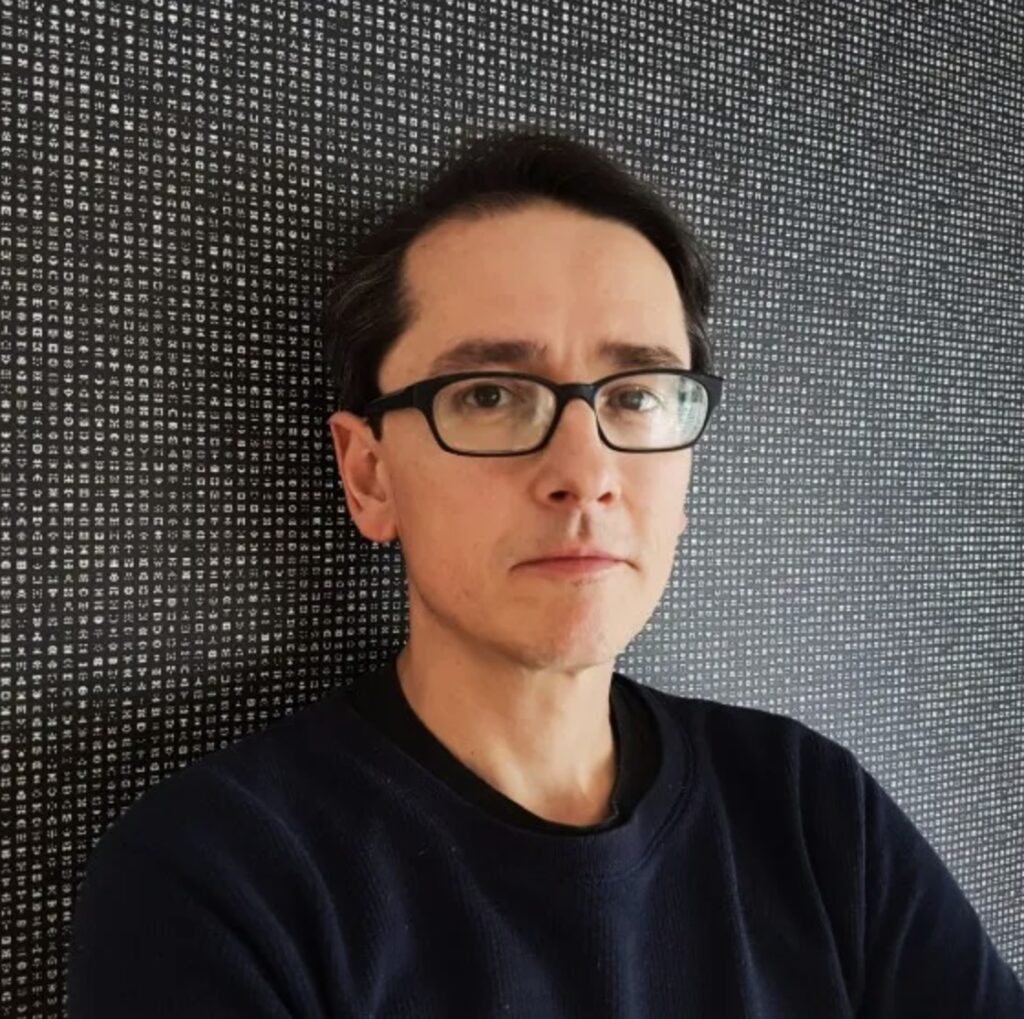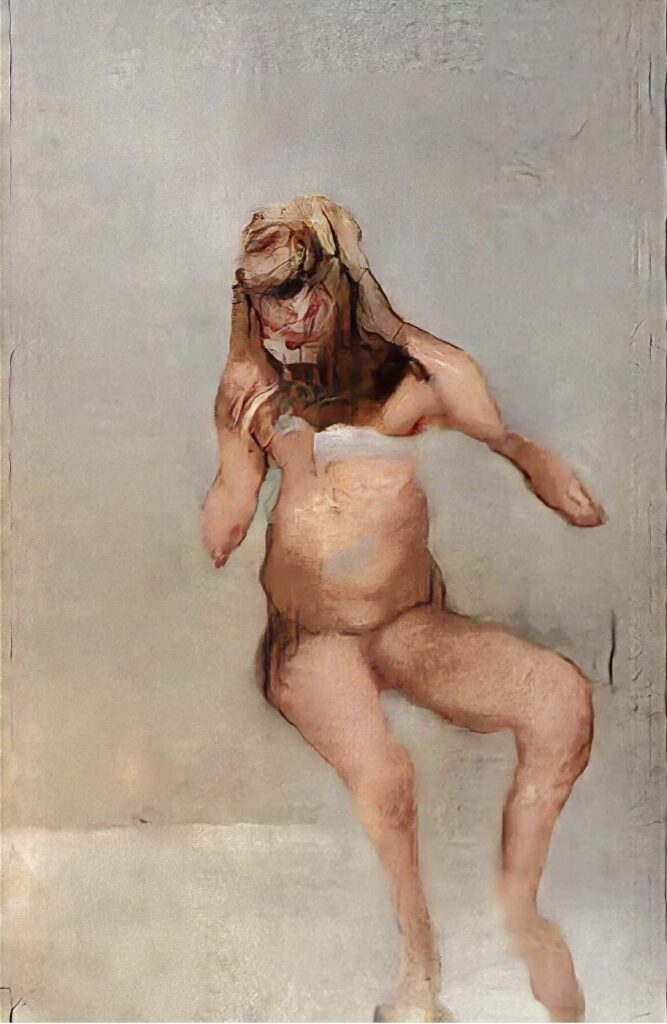Pau Waelder

Mario Klingemann, born in Laatzen, Germany in 1970, is an artist who integrates algorithms and artificial intelligence into his creative process. His artistic exploration delves into visual expressions, linguistics, and our intricate interactions with technology. Klingemann’s creations, which primarily utilize generative adversarial networks (GANs), manifest as screen-based artworks or interactive installations. These installations captivate audiences with a never-ending array of visual experiences, where the AI models crafted by Klingemann generate portraits, abstracted figures, or textual content in real-time.
Recognized as a pioneering figure in the realm of AI-art, Klingemann’s contributions include a tenure as Artist in Residence at Google Arts and Culture from 2015 to 2018. His collaborations extend to notable institutions like the British Library and the New York Public Library. In 2018, he was honored with the prestigious Lumen Prize Gold Award. Klingemann’s work has been showcased at eminent art venues globally, including the Centre Pompidou in Paris, The Barbican Centre in London, and the Hermitage Museum in St. Petersburg.
In this article, based on the text written for the exhibition Latent Spaces that I curated for La Bibi Gallery (Mallorca, Spain) featuring the work of Mario Klingemann and the Finnish duo Grönlund-Nisunen, I offer a brief overview of the main subjects in Klingemann’s work. On the occasion of this exhibition, Niio is presenting a selection of artworks by Mario Klingemann, courtesy of Onkaos.
Explore the wilderness of AI in Mario Klingemann’s artworks
Mario Klingemann. Sirius A, 2019. Courtesy of Onkaos.
Latent space is the position relation of information
Borrowing László Moholy-Nagy’s reflections about architecture in his book The New Vision (1927), Klingemann describes the term “latent space,” commonly used in machine learning processes, as “the position relation of information.” Latent spaces are not physical spaces, but rather a way to describe how an artificial intelligence system processes the information it takes from a data set and creates clusters of items that resemble each other, according to a set of variables. Klingemann explores latent spaces as realms of endless possibilities, looking for the unexpected, the rare and weird, that which pushes his creativity further. For him, AI is not a technology that replaces the artist, but one that provides creators with new ways to develop their talent. In his work, we find endless processes fueled by “untamed” artificial neural networks that generate uncanny images and responses. Faced with this creative otherness, one must find one’s position as a viewer whose aesthetic and narrative expectations are challenged.
Nowadays, the most popular AI applications excel at creating realistic depictions of things we have seen thousands of times, or unconventional combinations of familiar images (such as a dog dressed as an astronaut riding a horse on the Moon) with impressive accuracy. However, Klingemann finds this approach predictable and boring, and aims to drive the system into the unpredictable: “[the popularization of] one-click AI art tools… forces me to look for areas out there that I still consider “wilderness” and to learn more about what it is that we humans find truly interesting and captivating.” The Hyperdimensional Attractions series addresses the unexpected by applying a three-body problem to a latent space, resulting in a triptych showing images that change according to how the feature vectors they represent “orbit” around each other. What the viewer sees is a triptych of familiar images always mutating into weird shapes and amalgamations: it is precisely these unsettling figures that interest Klingemann in his exploration of the fringes of representation.
Mario Klingemann. Three Latent Body Problem, 2023. Courtesy of Onkaos.
Datasets and appropriation
Generative neural networks are trained using datasets, and therefore the content of these datasets is crucial. Artists such as Anna Ridler create their own datasets by making hundreds of drawings or taking thousands of photographs, while others incorporate their own writings into a machine learning model in order to create an alter ego of sorts, as do Mark Amerika and Sasha Stiles. Mario Klingemann carries out a particular form of appropriation by using datasets of thousands of images or, more particularly, taking Hyeronimus Bosch’s The Garden of Earthly Delights (1490-1500) as the base material for The Garden of Ephemeral Details. In this artwork, an autonomous AI machine made of several generative adversarial networks (GANs) constantly reinterprets the famous triptych by adding new forms to its unsettlingly surreal iconography. Klingemann uses Bosch’s masterpiece as a field of algorithmic interpretation, forcing the machine to explore the “wilderness” of artistic creation by providing a peculiar data set in the form of the Dutch artist’s singular combination of religious imagery and unbridled fantasy. The resulting artwork thus becomes an experiment in machine hallucination and artificial imagination.
Mario Klingemann. The Garden of Ephemeral Details Reserve #2, 2020. Courtesy of Onkaos.
Motion and process
Moholy-Nagy was one of the pioneering artists exploring kinetic sculpture and the use of light and industrial materials in assemblages and installations. Kinetic art also influenced early algorithmic art, with pioneers such as Manfred Mohr seeking to portray motion in abstract generative artworks and finding in personal computers a tool to create visual compositions in perpetual transformation. Mario Klingemann follows this tradition by using generative adversarial networks to create images that are not static but constantly and seamlessly morph into new shapes, accentuating the fact that the process takes precedence over the finished product. The Hyperdimensional Attractions series and The Garden of Ephemeral Details clearly show this particular decision. The former explore the position relations of feature vectors in the latent space, the resulting images becoming a way to visualize these relations. The latter deconstructs Bosch’s triptych in order to portray the effort of the machine as it tries to stretch its imagination.

Latency
Motion and process imply change taking place in a certain time and space (real or virtual). Change, in turn, implies that something is about to happen. There is expectation, as one waits for the next step in the process. Paradoxically, latency is found in Klingemann’s prints, static images that nevertheless potently evoke transformation. The Imposture series explores the representation of the human body through AI models, resulting in six compositions that the artist selected from 50,000 images generated by the program. Some of the images vaguely remind of paintings by Francis Bacon but have a decidedly non-human quality to them: they lack the natural notions of the shape of the human body and the empathy that a human artist would feel. In an even more disturbing turn, the Neural Decay series evoke early photographic portraiture, again in a form that distills otherness and the uncanny. These artworks seem in the process of dissolving, their shapes blending into each other, as if they were about to turn into an amorphous substance or simply vanish. As we observe and wait for this to happen, a space of latency opens before our eyes.
References
Jochen Gutsch (2021). “Words behave like pixels and sentences like pictures”: An interview with Mario Klingemann. Goethe Institut.
Mario Klingemann (2023). Latent Talent. A*Desk. Critical Thinking.
